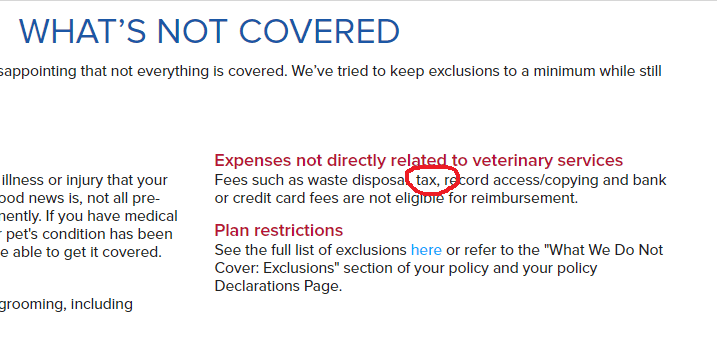With so many options to choose from, finding the right pet insurance plan for your pet can be hard. No two pet insurance plans are alike, but that is often hard to see when you are trying to compare plans based on their websites. As they say the devil is in the details. To truly understand what you are buying you need to read the fine print. Join us as we review 8 items you should know about before you buy pet insurance.
8 Things You Should Know About Pet Insurance Before You Buy
Take a look at these 8 items you should know about pet insurance before you buy. But you probably don’t.
1. Your premiums will increase over the lifetime of your policy
Most people use the cost of the plan at the time of enrollment to decide which plan to pick. This is because with a lack of additional information we often make the decision based on affordability.
Don’t Let Yourself Get Tricked!
Pet insurance companies have been known to lure consumers in with low monthly rates only to have those rates increase significantly after the first year or two of coverage. It doesn’t stop there. These same companies will continue to increase the rates until they become prohibitively high.

Pet insurance can be expensive- Would you like to save a little money? Here are 5 ways to get a discount on Pet Insurance
Why Do Premiums Increase?
Insurance companies often cite the higher cost of claims as a pet age. While it may be true that a 10 year old dog will have higher health costs than a puppy, it does not always justify the high increases. Too often pet owners find themselves without coverage when they need it most. This can happen after years of paying for it just because it became too expensive.
Know what factors the plan uses to determine annual increases before buying Pet Insurance:
Age
Many plans base the increase on the age of the dog whether or not it is justified. Although all policies holders will see an increase in the cost of coverage as their pets age, look for an insurer that does not increase costs annually purely due to age. This information can be hard to find. Sometimes you can find it in the FAQ. If all else fails try calling the company, but get the answer in writing. If the company you are interested in states they increase rates based on age find out how often.
Tip: If you can’t find the information on rate increases in the FAQ, try typing in “What will cause your premiums to change?” or “Will my rates increase?” in the search function of the website
Claims
Some companies will increase the cost of coverage after a claim. Stay away from these companies. This information may be hard to find on a company’s website.
Tip: Try checking review sites and the BBB to see if you find complaints about a company you are interested in. If a company has a history of increasing premiums after claims you may be able to find someone complaining about it.
Health Trends
Most insurers will increase the cost of insurance based on health trends. Just like with human health insurance coverage if there is an upward trend in health care costs, the increases are passed on to the policy holders. This could be caused by an increase in the veterinary costs due to inflation, or the increase in cost of care for an older pet. New technologies and services can also increase the cost of insurance.
2. Age May Determine Available Plans
Age not only affects the premiums but can also determine the coverage you are eligible for.
For example: Nationwide Pet Insurance only offers Major Medical for dogs under 1 year of age. Their Major Medical plan benefits are paid on a schedule. This means that they cap the amount of benefits you can receive based on this schedule. To get the full benefits advertised on their website you need to upgrade your plan to one of their whole pet plans after your pup turns one.
On the other end of the age spectrum once your pups turns 10 under Nationwide, they no longer qualify for the major medical plan. All this information is front and center on Nationwide’s pet insurance site, but may not be fully disclosed if enrolling by phone.
Tip: When researching plans make sure to check to see if the plan is limited based on your pets current age or future age. If speaking to a representative always get the information in writing!

There are 9 common mistakes people make when deciding to buy Pet Insurance. Do you know what they are?
3. Exams may not be covered
One of the most surprising things I discovered while researching plans is that many pet insurance plans do not cover exams. I don’t mean just wellness exams. Even the some of the best insurers don’t cover exams for sick and injury pets. Exams are often the largest cost when a pet is sick. If this is important to you, look for a plan that covers exams.
4. Payments may be based on R&C
Does the plan state that they will pay “Up to 90% back on vet bills”? Does this sound too good to be true? It just may be. Some insurers calculate the percentage of reimbursement on what is considered the customary and reasonable cost of the procedure. Depending on where you live and your veterinarian, this could be less than what you actual paid.

Is Pet Insurance really worth the cost of the plan? Or, would we be better off just putting that money in a saving account to use if and when it is needed?
5. Taxes may not be reimbursed
Some insurer will only pay for the actual cost of the procedure or treatments, not the cost of the associated tax. For some states this can be as much as 18% added to your cost. This information is generally not that hard to find, since it is often used as a way to differentiate plans. Just look under “What’s covered” or “What’s Not Covered” on their websites.

Check to see if your state charges tax on veterinary medical and non-medical services
6. Maximum Plan Limits
Maximum plan limits can take many forms. The plan might have an annual maximum limit which means that once they have paid out the annual amount they will not pay anything else for the remainder of the plan year.
There are also lifetime limits which like annual limits cap the amount paid on a policy for the lifetime of that policy. Some insurers will place maximum payout limits on procedures. These types of limits are often called a schedule of payments.
Tip: Even plans that state they cover up to 90% of claims can have maximum limits to cap the amounts they have to pay out. All limits should be stated in the policy.
7. Deductibles for Wellness Plans
Some plans will lump their wellness plans and sick/accident plans in one plan with the same deductible. If you have a healthy pet that only sees the vet for an annual check-up you may not exceed the annual deductible making the wellness portion of the plan useless.
8. Pre-existing conditions
All plans have limits on pre-existing conditions but how they are determined can vary from plan to plan. Make sure you understand what a pre-existing condition is under the plan you are interested in. In some plans it may be a condition that was discovered the prior plan year even though you are covered by the same insurer for both years.
The bottom line
Before purchasing any pet insurance plan ask for a copy of the policy. Then make sure to read and understand everything in the policy. If you don’t understand something, ask the insurer questions and get the response in writing.
For more tips on buying pet insurance check out my other posts:
- Is Pet Insurance worth it?
- Pet Insurance – 5 Ways to Find a Discount
- 9 Common Mistakes When Buying Pet Insurance
Legal disclaimer
Happyoodles tries to ensure the information provided on this site is accurate and reliable. However information is provided “as is” without warranty of any kind. Happyoodles does not accept any responsibility or liability for the accuracy, content, completeness, legality, or reliability of the information contained on this website.
No warranties, promises and/or representations of any kind, expressed or implied, are given as to the nature, standard, accuracy or otherwise of the information provided in this website nor to the suitability or otherwise of the information to your particular circumstances.

Ruth Epstein
Saturday 19th of October 2019
Pet Insurance is so important and thank goodness I have that covered as I would rather be safe than sorry especially as Layla is getting older. I am also blessed is that I can email my vet with questions and not charged for them replying which makes life easier
Molly Weinfurter
Friday 18th of October 2019
This is some great advice. I do not currently have pet insurance for my dogs, but I will likely get it in the future, so this is some useful information that I will have to consider.
Bonnie
Friday 18th of October 2019
Thank you for taking the time to comment. It is so nice to hear from readers and get their prospective on the topic.
Dachshund Station
Thursday 17th of October 2019
Nice Post, I haven't purchased Pet Insurance for my dogs as of yet. I appreciate your helpful tips and things to be aware of. I know there are pros and cons to purchasing pet insurance. It really is a tough decision. (From Dachshund Station)
Bonnie
Friday 18th of October 2019
Thanks! There is so much information that people really need to understand before buying pet insurance. I hope this article will help someone make an informed decision.
Melanie Varey
Thursday 17th of October 2019
This is useful information, especially for first time pet owners or pet insurance customers.
Bonnie
Friday 18th of October 2019
Thank you for reading. I plan to add more articles on purchasing pet insurance so check back when you get a chance.